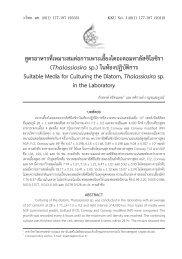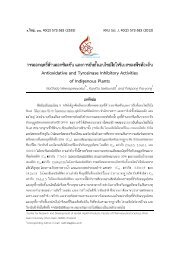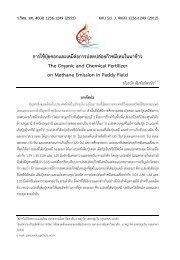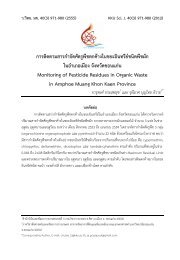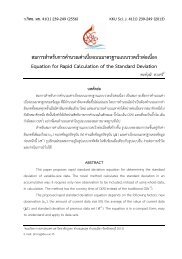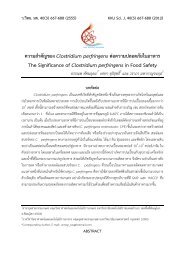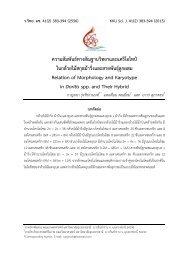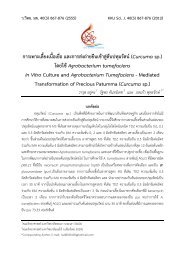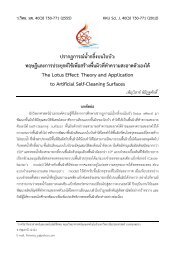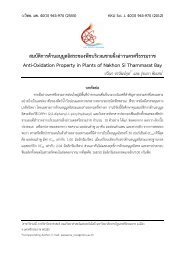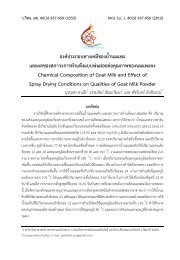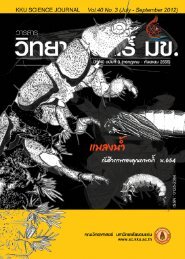Review
Review
Review
Create successful ePaper yourself
Turn your PDF publications into a flip-book with our unique Google optimized e-Paper software.
114 KKU Science Journal Volume 39 Number 1 Research<br />
Introduction<br />
Chitosan is an N-deacetylated product of<br />
chitin which is a natural carbohydrate polymer found<br />
in crab and shrimp shells, which are waste products<br />
from food-processing. Chitin is also found in wings<br />
of some insects such as butterflies and ladybugs,<br />
as well as in cell walls of yeast, mushroom and<br />
other fungi (Devlieghere et al., 2004). Chitosan<br />
production involves three steps: deproteination,<br />
demineralization and deacetylation. Chitosan has been<br />
applied in waste water treatment, biotechnology.<br />
In agriculture, chitosan has been primarily use to<br />
enhance plant growth and to boost the ability of<br />
plant in defending against fungal infections (Hadwiger<br />
et al., 2002; Barka et al., 2004). Phalaenopsis is a<br />
dominantly epiphytic genus and most intensively<br />
hybridized and propagated orchids. Phalaenopsis has<br />
been known worldwide as the most valuable potted<br />
plant. In Thailand, multiplication by tissue culture is<br />
mostly done for mass-propagation (Young et al.,<br />
2000). There have been many reports that chitosan<br />
has ability to stimulate the differentiation of orchid<br />
plant tissue (Limpanavech et al., 2003; Nge et al.,<br />
2006; Pornpienpakdee et al., 2010; Kananont et al.,<br />
2010). The objectives of the present study was to<br />
determine the effect of chitosan, prepared from<br />
cuttlebone, on micropropagation of P. cornucervi<br />
(Breda) Blume & Rchb.f. This is the first attempt<br />
to prepared chitosan from cuttlebone and use it to<br />
enhance the growth of P. cornucervi (Breda) Blume<br />
& Rchb.f.<br />
Materials and Methods<br />
Preparation of chitosan<br />
Chitosan was prepared from cuttlebones<br />
using the modified process of Alimunair and<br />
Zainuddin (1992). Cuttlebones were obtained from<br />
Teppitak Seafood Co.Ltd., Pattani, Thailand. They<br />
(100 g) were cleaned with water and deproteinized<br />
by treating with 4% sodium hydroxide for 4 h<br />
and washed with distilled water to neutralize pH.<br />
After this step, they were demineralized at room<br />
temperature with 4% hydrochloric acid for 24 h,<br />
washed with distilled water and then dried. The<br />
obtained chitin was deacetylated using 50% sodium<br />
hydroxide solution for 3 h. Samples were washed<br />
with distilled water and dried in an oven at 80 ÌC.<br />
Degree of Deacetylation (DD)<br />
Chitosan was dissolved and stirred in 0.1<br />
M acetic acid. After 24 h 10% sodium hydroxide<br />
was added and stirred for 4 h. The mixture was<br />
washed with distislled water to neutralize pH and<br />
then wash with ethanol. The film of chitosan was<br />
incubated in dessicator for 24 h and evaluated the<br />
degree of deacetylation using Fourier Transform<br />
Infrared Spectrometry, employing the method of<br />
Baxter et al. (1992).<br />
Plant materials<br />
The mature pods of P. cornucervi (Breda)<br />
Blume & Rchb.f. were surface sterilized with water<br />
and then dipped in 95% ethanol and flamed in a<br />
short period for 3 times. Seeds were scapen from<br />
the placentae and put on Vacin and Went (VW)<br />
(1949) medium and incubated at 25+2 ÌC in the<br />
darkness, all germinated seeds were moved to light<br />
condition for further development.<br />
Effect of chitosan on protocorm growth<br />
and development in liquid and semi-solid medium<br />
The 12 week-old protocorms were used as<br />
explant in VW liquid and solid medium. Protocorms<br />
(0.6 g fresh weight/flask) were cultured in VW<br />
liquid medium, supplemented with chitosan 5, 10,



